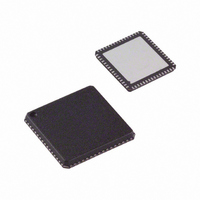AD1994ACPZ Analog Devices Inc, AD1994ACPZ Datasheet - Page 18

AD1994ACPZ
Manufacturer Part Number
AD1994ACPZ
Description
IC AMP AUDIO PWR 25W 64LFCSP
Manufacturer
Analog Devices Inc
Type
Class Dr
Datasheet
1.AD1994ACPZ.pdf
(24 pages)
Specifications of AD1994ACPZ
Output Type
2-Channel (Stereo)
Max Output Power X Channels @ Load
25W x 2 @ 6 Ohm
Voltage - Supply
4.5 V ~ 5.5 V
Features
Depop, Mute, Short-Circuit and Thermal Protection
Mounting Type
Surface Mount
Package / Case
64-LFCSP
Operational Class
Class-D
Audio Amplifier Output Configuration
1-Channel Mono/2-Channel Stereo
Output Power (typ)
50x1@3Ohm/25x2@6OhmW
Audio Amplifier Function
Speaker
Total Harmonic Distortion
0.003@1W%
Single Supply Voltage (typ)
Not RequiredV
Dual Supply Voltage (typ)
5/20V
Supply Current (max)
260@12V/27@5V/7@5VmA
Power Supply Requirement
Triple
Rail/rail I/o Type
No
Power Supply Rejection Ratio
65dB
Single Supply Voltage (min)
Not RequiredV
Single Supply Voltage (max)
Not RequiredV
Dual Supply Voltage (min)
4.5/6.5V
Dual Supply Voltage (max)
5.5/22.5V
Operating Temp Range
-40C to 85C
Operating Temperature Classification
Industrial
Mounting
Surface Mount
Pin Count
64
Package Type
LFCSP EP
For Use With
EVAL-AD1994EBZ - BOARD EVAL FOR AD1994
Lead Free Status / RoHS Status
Lead free / RoHS Compliant
Available stocks
Company
Part Number
Manufacturer
Quantity
Price
Company:
Part Number:
AD1994ACPZ
Manufacturer:
ADI
Quantity:
260
Part Number:
AD1994ACPZ
Manufacturer:
ADI/亚德诺
Quantity:
20 000
AD1994
Output Transistor Nonoverlap Time
The AD1994 allows the user to select from one of eight different
nonoverlap times, as shown in Figure 46. Nonoverlap time
prevents or minimizes the period during which both the high-
side and low-side devices are on simultaneously due to propagation
delays and nonzero rise and fall times. If both the upper and
lower portions of a half-bridge conduct simultaneously, there is a
path directly from the power supply to ground and an induced
current flow known as shoot-through. However, introducing
this delay increases distortion by pushing the switching pattern
further from an ideal two-state waveform. Selecting the
nonoverlap delay requires a compromise between distortion
and efficiency. The logic levels on the three delay control pins,
DCTRL2, DCTRL1, and DCTRL0, set the nonoverlap time
according to
rising edge of RESET and should not be changed while RESET
is logic high.
Table 12. Nonoverlap Time Settings
DCTRL2
0
0
0
0
1
1
1
1
1
The shortest setting (DCTRL[2:0] = 111) or the second shortest
setting (DCTRL[2:0] = 111) is recommended for most applications.
These two settings allow a small trade-off between efficiency
and distortion. Longer nonoverlap times generally increase
distortion while providing little or no decrease in shoot-
through current.
CLOCKING
The AD1994 Σ-Δ modulator requires an external clock source
with a nominal frequency of 12.288 MHz. This clock can come
from a crystal or from an existing clock signal in the application
circuit. The discrete time portions of the modulator run internally
at 6.144 MHz, corresponding to 128 × f , where f
Values are typical and are not production tested.
GATE DRIVE
GATE DRIVE
HIGH-SIDE
LOW-SIDE
Figure 46. Half-Bridge Nonoverlap Delay Timing
Table 12. The state of DCTRL[2:0] is read on the
DCTRL1
0
0
1
1
0
0
1
1
t
NOL
DCTRL0
0
1
0
1
0
1
0
1
Nonoverlap Time (ns)
62
49
37
24
15
13.5
12
9
S
t
NOL
S
= 48 kHz.
1
Rev. 0 | Page 18 of 24
As mentioned in the
a noise-shaping effect such that SNR is increased within the
audio band by shifting modulator quantization noise upward in
frequency. For external clock frequency of 12.288 MHz, the
modulator’s noise-shaping works in a manner that results in a
flat noise floor at the amplifier output for frequencies 20 kHz
and below. Above 20 kHz, the amplifier noise rises due to the
spectral shaping of the modulator quantization noise. At very
high frequencies, the noise floor levels off and decreases due to
poles in the modulator noise-transfer function and in the
external LC filter.
The clock frequency does not have to be exactly equal to
12.288 kHz and can vary by up to ±10%. For other rates, the
noise corner scales linearly with frequency. When the modulator
runs at a rate lower than nominal, the average power stage
switching frequency decreases, the efficiency increases slightly,
and the noise floor begins to rise at a slightly lower frequency.
Likewise, a faster clock gives slightly increased bandwidth and
slightly lower efficiency.
Using a Crystal Oscillator
The AD1994 can use a crystal connected to the CLKI and
CLKO pins as a master clock source, as shown in
CLKI and CLKO pins connect to an internal inverter to create a
full resonator. The typical values shown work in many applications,
but the crystal manufacturer should provide the exact type and
value of the capacitors and the resistor.
Using an External Clock Source
If a clock signal of the appropriate frequency already exists in
the application circuit, connect it directly to CLKI and leave
CLKO floating. The logic levels of the square wave should be
compatible with those defined in
Large amounts of jitter on the clock input degrade performance.
Whenever possible, avoid passing the clock signal though
programmable logic and other circuits with unknown or variable
propagation delay. In general, clock signals suitable for audio ADCs
or DACs are also appropriate for use with the AD1994.
22pF
Figure 47. Crystal Connection
Σ-Δ Modulator
XTAL
47Ω
Specifications section.
section, the modulator has
22pF
Figure 47. The













